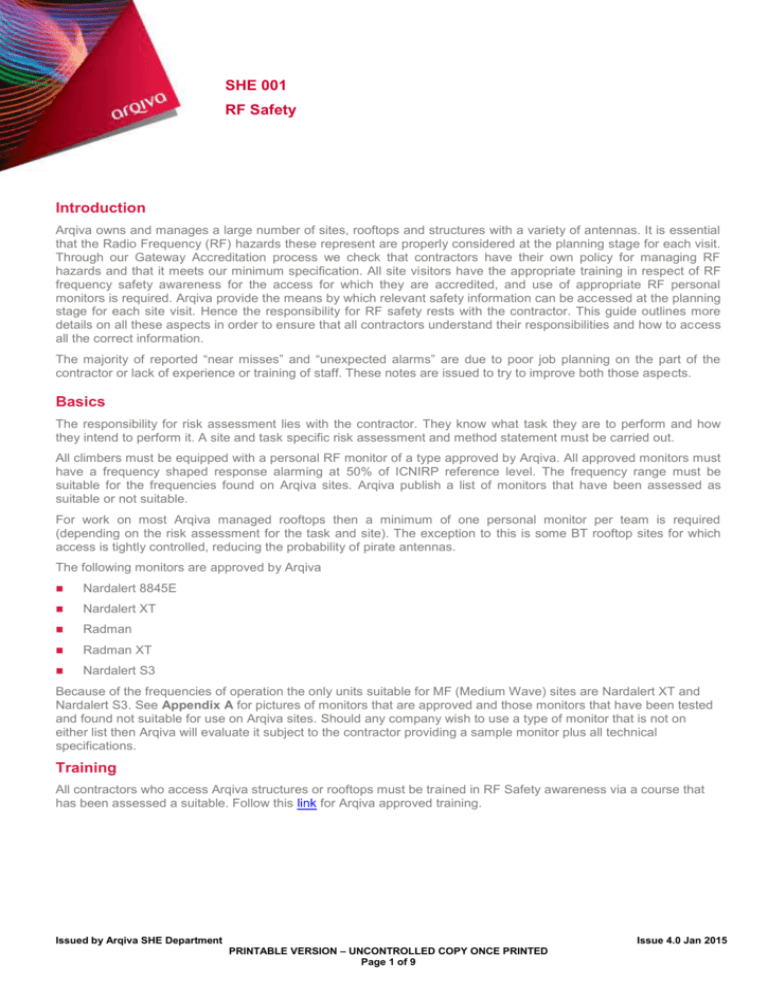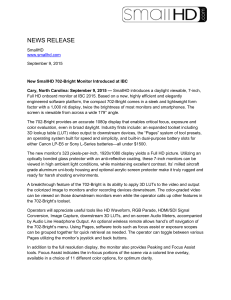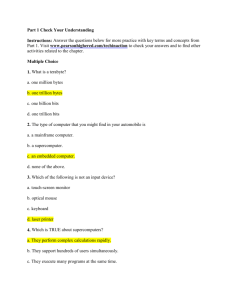SHE RF Safety
advertisement

SHE 001 RF Safety Introduction Arqiva owns and manages a large number of sites, rooftops and structures with a variety of antennas. It is essential that the Radio Frequency (RF) hazards these represent are properly considered at the planning stage for each visit. Through our Gateway Accreditation process we check that contractors have their own policy for managing RF hazards and that it meets our minimum specification. All site visitors have the appropriate training in respect of RF frequency safety awareness for the access for which they are accredited, and use of appropriate RF personal monitors is required. Arqiva provide the means by which relevant safety information can be accessed at the planning stage for each site visit. Hence the responsibility for RF safety rests with the contractor. This guide outlines more details on all these aspects in order to ensure that all contractors understand their responsibilities and how to access all the correct information. The majority of reported “near misses” and “unexpected alarms” are due to poor job planning on the part of the contractor or lack of experience or training of staff. These notes are issued to try to improve both those aspects. Basics The responsibility for risk assessment lies with the contractor. They know what task they are to perform and how they intend to perform it. A site and task specific risk assessment and method statement must be carried out. All climbers must be equipped with a personal RF monitor of a type approved by Arqiva. All approved monitors must have a frequency shaped response alarming at 50% of ICNIRP reference level. The frequency range must be suitable for the frequencies found on Arqiva sites. Arqiva publish a list of monitors that have been assessed as suitable or not suitable. For work on most Arqiva managed rooftops then a minimum of one personal monitor per team is required (depending on the risk assessment for the task and site). The exception to this is some BT rooftop sites for which access is tightly controlled, reducing the probability of pirate antennas. The following monitors are approved by Arqiva Nardalert 8845E Nardalert XT Radman Radman XT Nardalert S3 Because of the frequencies of operation the only units suitable for MF (Medium Wave) sites are Nardalert XT and Nardalert S3. See Appendix A for pictures of monitors that are approved and those monitors that have been tested and found not suitable for use on Arqiva sites. Should any company wish to use a type of monitor that is not on either list then Arqiva will evaluate it subject to the contractor providing a sample monitor plus all technical specifications. Training All contractors who access Arqiva structures or rooftops must be trained in RF Safety awareness via a course that has been assessed a suitable. Follow this link for Arqiva approved training. Issued by Arqiva SHE Department Issue 4.0 Jan 2015 PRINTABLE VERSION – UNCONTROLLED COPY ONCE PRINTED Page 1 of 9 Information provided by Arqiva for risk assessment Prior to planning any task on site the Risk Register for the site should be consulted. Considerable changes have been made to the Risk Registers on Gateway during the Gateway improvement project. The generic risks have been removed and the information now focuses on site specific risks and detail RF safety information for the site. The Risk Register can be emailed to any valid email address so access to Gateway is not necessary. The person within the company who has a Gateway account can request the risk information to be sent to a colleague for example. Instructions and screen shots on how to request Risk Register by email From the Gateway home page, find the site required by using the ‘Quick Find’ or the ‘Find Site’ buttons The Gateway page for your site will open. Next select the ‘Request RR + AIR Report’ button The screen below will open. Enter your email address in the box and select the ‘Save’ button PRINTABLE VERSION – UNCONTROLLED COPY ONCE PRINTED Page 2 of 9 The PDF of the Risk Register + AIR will be emailed to your chosen address. What does the Risk Register include, and how to use it Site specific general risks This includes any risks that are specific to this site. Sometimes risks are of a temporary nature and if you notice on your visit that one of these risks is no longer valid then please report it via your post work report. RF Safety Noticeboard The RF Safety Noticeboard details any known risks in the climbing zone. The climbing zone is defined as the ladder and rest platforms. Information in the RF Safety Noticeboard will detail where the restriction is and what planned work is needed to work in that area. If the restriction is applicable to your task then make sure you speak to the Site PRINTABLE VERSION – UNCONTROLLED COPY ONCE PRINTED Page 3 of 9 Access team to request that the planned work is booked. Broadcast customers need a minimum of 2 weeks notice for outages and power reductions. Your task may mean that you need to work off the ladder and climb around the structure to access your work area. The Information in the RF Safety Noticeboard cannot take that into account and as a trained contractor you are expected to understand industry standard exclusion zones. To understand which antennas you need to pass or work close to then you must consult the Antenna Information Report (AIR). Antenna Information Report (AIR) This gives a full listing in height order of all the antennas on the structure. The customer information will be listed as either “Arqiva” or “other”. Where it is listed as Arqiva this may indicate that the antenna is used for Broadcasting. There is also a field to indicate that the antenna is used for paging. In Arqiva’s experience it is broadcasting and paging antennas that are overlooked by some contractors in their risk assessment. The AIR can also be used on site as a written “map” of the structure. Please ensure that any errors you notice are fed back via your post work report. Paging antenna May be Broadcast antennas PRINTABLE VERSION – UNCONTROLLED COPY ONCE PRINTED Page 4 of 9 Proper use of all the information provided in the Risk Register should prevent the large number of reported “unexpected alarms” and near misses. Frequently it is found that “unexpected Alarms” are reported when the work area is only 1 m away from a paging or Broadcast Radio antenna for example. These could and should have been expected if the risk assessment had been carried out properly. Use of RF Safe System of Work Clearly when you are working on your customer’s antenna you will have in place a process to ensure that you or your customer removes the power to the antenna prior to your work. When your task requires that other services need to be reduced in power or shutdown to give you safe access then you are required to follow the Arqiva Safe System of work procedure. This requires that all the parties involved (the climbing team, the Arqiva representative and any engineers attending site to switch transmitters) have a discussion about what is to be done and how and by whom, and document it on the RF Safe System of Work form before any work commences on site. It is the contractor’s responsibility to bring the Safe System of Work form to site with them. False alarms and Minimum measurement distance Arqiva have worked closely with all of the training providers that are approved to ensure that they adequately cover the issue of false alarms. Jobs are stopped on site frequently due to false alarms. All personal monitors have a minimum measurement distance. This is the distance that the monitor must be from any metal object for it to function correctly. When metal is placed closer than this minimum measurement distance it can cause the monitor to false alarm due to capacitive coupling of energy directly into the monitor. An example of this is where a climber is in close proximity to a latchway cable. The latchway cable acts as an antenna channelling energy into the monitor and making it alarm. When a monitor alarms on site staff should first ascertain how close they are to latchway bonds, feeders metal work etc. and if it is closer than 100 mm then re-position to a distance where the monitor is more than 100 mm away from metal (in free space) and see if the alarm continues. In situations where there is a significant level of RF personal monitors will alarm constantly. The occasional bleep, especially in areas where the personal monitor touches the ladder as it is climbed, are not usually considered to be real alarms. Sites with Medium Wave radio “MF SITES” Some Arqiva sites have medium wave radio antennas. These can be structures where the structure itself is the antenna or where long wire antennas are supported by an earthed structure. On this type of site there is the additional hazard of RF pickup, to any long pieces of metal that are taken onto site. Arqiva have a briefing document on this and the measures taken to avoid it, mostly by earthing which can be provided on request (BOW885). A recent improvement to Gateway is that when you apply for access to a site that has an MF antenna you will be prompted with the following screen PRINTABLE VERSION – UNCONTROLLED COPY ONCE PRINTED Page 5 of 9 If you select “Acknowledge MF/LF Site” to indicate that you understand the hazards then your application will proceed as normal. If you select “Further Information” then you will be taken to a copy of Arqiva document BOW885 MF sites, Hazards and Precautions which you should read and understand, and ensure that your risk assessment has considered the hazards before continuing your application. Because of the frequencies in use only Nardalert XT and Nardalert S3 monitors are suitable for use on MF sites. These should always be worn on the body (as they are designed to be used) for most accurate results on this type of site. Emergencies All accident, incidents and near miss must be reported to the Arqiva Accident Report Line by ringing 01926 416650. If you have been involved in a suspected RF overexposure, ring Site Access on 01962416236. The Site Access team will arrange to fax RF information for doctors to the medical facility that the individual is attending. Most doctors do not fully understand the effects of RF and it is important that they receive this information so they can accurately diagnose any health implications and provide the correct treatment. Appendix A RF monitors approved for use on Arqiva Sites: Section 5.3 of BOP034 Arqiva Access Regulations states: An Arqiva approved RF meter or monitor is to be used at all times when accessing a structure. Visitors ascending a structure must ensure that they do not stray outside the area specified on the access authorisation for that site. Arqiva specify that all climbers on our structures, and one per team on rooftops, must use a personal monitor with a shaped response that is designed to alarm at 50% of ICNIRP occupational. This is because of the broad range of broadcasting and telecommunications systems found on our sites. Units that meet this specification are, Nardalert XT D8862, Nardalert 8845-E, Radman Monitors and Nardalert S3. Other equipment may also be fit for purpose but this must be verified by Arqiva prior to use on site. PRINTABLE VERSION – UNCONTROLLED COPY ONCE PRINTED Page 6 of 9 Equipment type - Approved for use on Arqiva sites Narda 8845-E Narda XT D-8860 & D-8862 Narda S3 The following are also approved for use BUT are not used by Arqiva employees: Equipment Type - Not used by Arqiva staff Narda ESM-20 / Radman XT Narda 8846-D PRINTABLE VERSION – UNCONTROLLED COPY ONCE PRINTED Page 7 of 9 RF Monitors not suitable for use on Arqiva sites: The following RF monitors are NOT approved for use on Arqiva Sites: These monitors do NOT have a shaped response. Equipment type – NOT approved EME Guard GM H600A Com monitor Microalert T-MA-P2 Schomandl SafeOne PRINTABLE VERSION – UNCONTROLLED COPY ONCE PRINTED Page 8 of 9 This monitor has a shaped response but does NOT cover the full range of frequencies transmitted on Arqiva sites. Equipment type fieldSENSE This monitor has a shaped response but is shaped to a standard that is different to ICNIRP 1998. Narda 8845D PRINTABLE VERSION – UNCONTROLLED COPY ONCE PRINTED Page 9 of 9
![DEV0901 MIP parish council presentation[6]](http://s2.studylib.net/store/data/005501760_1-b6d93abfa534491f514ad86cf7fcdf40-300x300.png)



